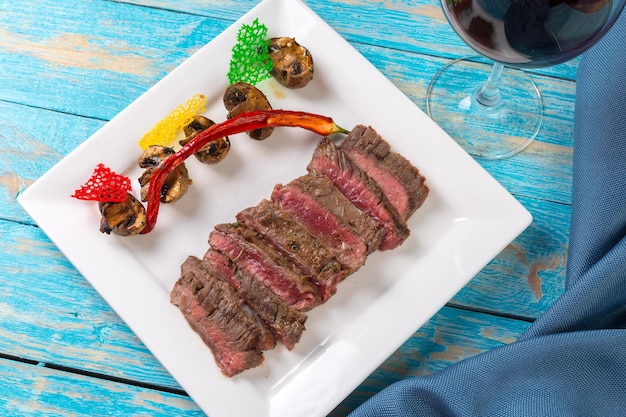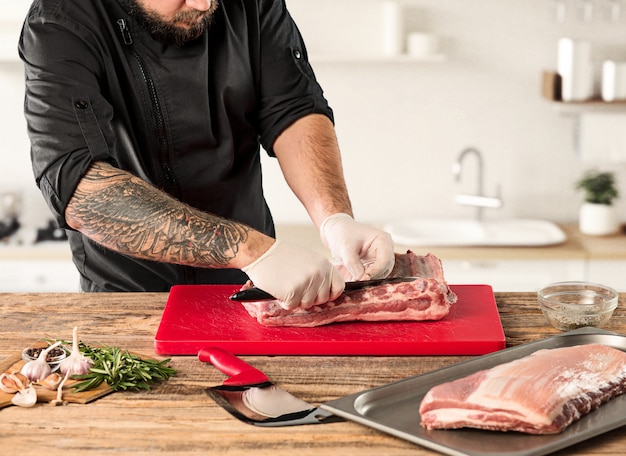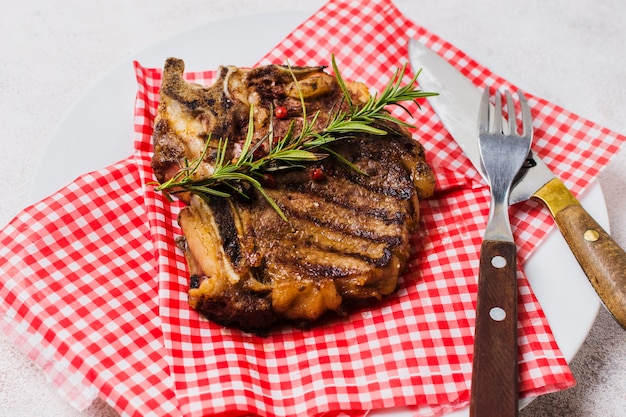Let’s talk strip loin steak. It's a cut that brings a smile to my face just thinking about it. A steak that deserves a prominent spot on your dinner table, more often than not. There's an almost magical quality about a perfectly cooked strip loin. The juicy tenderness, the beautiful sear, the flavour that explodes in your mouth – pure culinary bliss.
But honestly, it wasn’t always this way. I've made my fair share of mistakes over the years, from overcooked disasters to undercooked tragedies. It took a lot of trial and error, but eventually, I cracked the code, and now I can confidently call myself a strip loin master. So, I’m sharing all my secrets with you, because everyone deserves to experience the joy of a perfectly cooked steak.
(Part 1) choosing the right steak
We're going to start at the foundation: choosing the perfect strip loin. You wouldn't build a house on a shaky foundation, would you? Same goes for your steak!
1. The Cut

The strip loin is already a fantastic choice. It's naturally tender, with a good amount of marbling (those lovely streaks of fat that make it so juicy) and a great flavour. But within the strip loin family, there are a few variations to consider:
a) new york strip:
This is the classic choice. It has a nice rectangular shape and a good amount of marbling. It's often labelled as just "strip steak." It’s a versatile cut, perfect for grilling, pan-searing, or even roasting.
b) Kansas City Strip:
This one has a more square shape and a thicker, richer flavour, thanks to even more marbling.
c) Top Loin:
If you’re looking for a leaner option, this is it. It’s got a slightly more delicate flavour, but it’s still a great cut for grilling.
2. The Quality

Once you’ve chosen your cut, it’s time to consider quality. You want a steak that has a good colour - a deep red with a bit of marbling, and a firm texture. Avoid anything that looks dry, grey, or has a slimy texture. You can usually find good quality strip loins at your local butcher or at the grocery store.
3. The Thickness

For a perfectly cooked strip loin, you want a steak that’s at least 1 inch thick. This makes it easier to achieve that beautiful sear and get a nice even cook. However, if you’re using a pan or a skillet, you can get away with a slightly thinner cut (maybe 3/4 inch).
(Part 2) Preparation for Perfection
Choosing the right steak is just the first step. To achieve that mouthwatering result, you need to prep your steak like a pro!
1. Pat it Dry
Right after you bring your steak home from the store, pat it dry with paper towels. This helps to ensure a crispy sear.
2. Room Temperature
Before you even think about cooking your steak, let it come to room temperature. This ensures it cooks evenly, as the inside and outside of the steak are at a similar temperature. You can leave it on the counter for about 30-45 minutes.
3. Seasoning
Now, here’s where the fun begins! Salt and pepper are the absolute basics. However, for a truly delicious steak, I like to experiment with a few other seasonings.
a) My Go-To Rub:
1 tablespoon smoked paprika
1 teaspoon garlic powder
1 teaspoon onion powder
1/2 teaspoon dried thyme
1/4 teaspoon black pepper
1/4 teaspoon cayenne pepper (optional, for a little kick)
Mix all of this together and rub it all over your steak. Let it sit for at least 30 minutes, or even better, overnight. The salt draws out moisture from the steak, which then evaporates, concentrating the flavour.
4. Time to Rest
Once you’ve seasoned your steak, it’s time for a little rest. This allows the seasoning to penetrate the meat and really develop flavour.
(Part 3) cooking techniques for a Stellar Strip Loin
There are several ways to cook a strip loin steak, each with its own unique advantages. But the key is to find the method that works best for you and your taste buds.
1. Grilling
I’ll admit, grilling is my go-to method. There’s something about the smoky flavour and the beautiful char that you get on the grill that’s just irresistible.
a) Preheating the Grill
Start by preheating your grill to high heat. I usually aim for around 500°F (260°C). Make sure the grates are clean and well-oiled to prevent sticking.
b) Steak Time
Once the grill is hot, place the steak on the grates and close the lid. Let it cook for about 4-5 minutes per side for a medium-rare steak.
c) Resting
After cooking, take the steak off the grill and let it rest for 5-10 minutes before slicing and serving. This allows the juices to redistribute and makes for a more tender and juicy steak.
2. Pan-Searing
If you don’t have a grill, pan-searing is a great alternative. It’s a bit less fuss, and you can still achieve a beautiful sear and a juicy interior.
a) Heating the Pan
Start by heating a heavy-bottomed skillet or cast iron pan over high heat. Add a tablespoon of oil (I prefer a neutral oil like vegetable or canola) to the pan.
b) Searing Time
Once the oil is shimmering hot, place the steak in the pan and let it cook undisturbed for 3-4 minutes per side. Resist the urge to move it around too much; you want a nice crispy sear.
c) Resting
After searing, take the steak out of the pan and let it rest for 5-10 minutes before slicing and serving.
3. Sous Vide
For a truly foolproof method, sous vide is your best friend. It involves cooking the steak in a water bath at a precise temperature.
a) The Water Bath
Fill a pot or a large container with water and set it to your desired temperature. You want it to be at the desired doneness level.
b) Steak Prep
Seal the steak in a vacuum-sealed bag, then submerge it in the water bath. Let it cook for about 1-2 hours, depending on the thickness of the steak.
c) Searing
Once cooked, remove the steak from the bag and pat it dry. Heat a skillet over high heat and sear the steak for 1-2 minutes per side to create a beautiful crust.
d) Resting
After searing, let the steak rest for 5-10 minutes before slicing and serving.
(Part 4) Reaching Your Desired Doneness
This is where you can tailor the cook to your own preference. We’ll explore the different levels of doneness and how to achieve them.
1. Rare (125°F/52°C)
This is for the true steak purists. The centre will be red, and the outside will be a bit cool. The texture is very soft and juicy.
2. Medium-Rare (130°F/54°C)
My personal favourite! The centre will be pink, with a slight hint of red, and the outside will be warm. The texture is still very tender and juicy.
3. Medium (140°F/60°C)
This is where the centre starts to turn brown, and the steak is slightly more firm. The outside is still warm.
4. Medium-Well (150°F/66°C)
The centre is mostly brown, and the steak is more firm. The outside is hot.
5. Well-Done (160°F/71°C)
The centre is fully brown, and the steak is very firm. The outside is very hot.
(Part 5) Making the Most of Your Steak
You’ve cooked your perfect strip loin, but don’t stop there. Elevate the entire dining experience with these tips!
1. side dishes
A well-cooked steak deserves a great side dish to complete the meal.
a) Classic Pairings:
mashed potatoes: Creamy and comforting, a classic pairing for steak.
Roasted Vegetables: A simple, healthy and flavorful accompaniment.
Asparagus: Adds a bit of green freshness and contrasts well with the rich flavour of the steak.
Mac and Cheese: A cheesy, indulgent side dish that goes perfectly with steak.
b) Beyond the Classics:
Polenta: This creamy cornmeal porridge adds a touch of elegance and a subtle sweetness.
Risotto: A delicious and satisfying dish with a creamy texture and a great flavour.
Salad: A refreshing and light way to balance out the richness of the steak.
2. Sauces
Sauces can add a whole new dimension to your steak.
a) Simple Sauces:
Butter Sauce: Melt some butter in a pan and whisk in a little lemon juice and herbs.
Garlic Butter Sauce: Add a couple of cloves of garlic to the melted butter for a pungent flavour.
b) More Elaborate Sauces:
Béarnaise Sauce: A classic French sauce made with egg yolks, butter, and herbs.
Mushroom Sauce: A rich and earthy sauce made with mushrooms, wine, and cream.
Peppercorn Sauce: A spicy and pungent sauce made with cracked peppercorns, cream, and butter.
3. Serving it Up
A beautiful presentation can elevate your steak experience.
a) Slicing the Steak
Slice the steak against the grain. This ensures a tender bite.
b) The Plating
Arrange the steak slices on a plate with your chosen side dishes and sauce. You can also garnish it with fresh herbs or a sprig of rosemary.
(Part 6) Top Tips for a Perfect Strip Loin
These tips are like the secret sauce that takes your steak from good to amazing.
1. Don’t Overcook It!
The key to a juicy steak is not to overcook it.
2. Rest, Rest, Rest
Let your steak rest after cooking. This allows the juices to redistribute, resulting in a more tender and juicy steak.
3. Use a meat thermometer
The best way to ensure your steak is cooked to your liking is to use a meat thermometer. This takes the guesswork out of cooking and ensures that your steak is cooked perfectly every time.
4. Don’t Be Afraid to Experiment
Don’t be afraid to try new seasonings, sauces, and side dishes. You never know what flavour combinations you might discover!
(Part 7) Dealing with Common Steak Challenges
We’ve all been there! Let’s address some common mistakes and how to avoid them.
1. A Tough Steak
The most common issue is a tough steak. This usually happens when the steak is overcooked. To avoid this, use a meat thermometer and cook the steak to your desired doneness.
2. Uneven Cooking
Another issue is uneven cooking, where the outside is charred and the inside is raw. To prevent this, ensure the steak is at room temperature before cooking and cook it over a high heat.
3. Overly Seasoned
Don’t over-season! Too much salt can actually dry out the steak.
(Part 8) FAQs
Now, let’s answer some of the questions that always come up.
1. What is the Best Cut of Steak for Grilling?
You’ve got options! For grilling, I recommend a strip loin, a ribeye, or a New York strip. These cuts are naturally tender and marbled, which makes them perfect for grilling.
2. How Long Should I Grill a Steak?
The grilling time depends on the thickness of the steak and the desired doneness. A general rule is to grill for 4-5 minutes per side for a medium-rare steak. Use a meat thermometer to check the internal temperature and ensure it’s cooked to your liking.
3. How Do I Know When My Steak is Done?
You can use a meat thermometer, or you can use the “touch test”. Lightly press the centre of the steak.
Rare: The centre will be soft and cool.
Medium-Rare: The centre will be soft and warm.
Medium: The centre will be slightly firm and warm.
Medium-Well: The centre will be firm and hot.
Well-Done: The centre will be very firm and hot.
4. How Do I Get a Good Sear on My Steak?
To get a good sear, cook the steak over high heat and don’t move it around too much. Let it cook for 3-4 minutes per side before flipping.
5. How Do I Store My Steak?
To store your steak, wrap it tightly in plastic wrap or place it in a freezer-safe bag. Store it in the refrigerator for up to 3 days or in the freezer for up to 3 months.
There you have it. Armed with these tips and techniques, you’re ready to create a culinary masterpiece! Now go out there and enjoy the steak you deserve! Let me know what you think. Happy grilling!
(Part 9) Exploring Further: Beyond the Basics
For those who want to take their strip loin steak mastery to the next level, let’s delve deeper into some advanced techniques and considerations.
1. reverse searing
This method involves cooking the steak to your desired doneness in a low-temperature oven, then searing it over high heat to create a beautiful crust.
a) Low-Temperature Cooking:
Preheat your oven to 250°F (120°C). Place the seasoned steak on a baking sheet and cook for about 1-2 hours, depending on the thickness of the steak and your desired doneness.
b) Searing:
After cooking, remove the steak from the oven and let it rest for a few minutes. Heat a skillet over high heat and sear the steak for 1-2 minutes per side.
c) Resting:
Let the steak rest for 5-10 minutes before slicing and serving.
2. Understanding Temperature
A meat thermometer is your best friend when cooking a strip loin. It takes the guesswork out of cooking and ensures your steak is cooked perfectly every time. Here’s a breakdown of the ideal internal temperatures for different levels of doneness:
a) Internal Temperatures for Doneness:
| Doneness | Temperature (°F) | Temperature (°C) |
|---|---|---|
| Rare | 125-130 | 52-54 |
| Medium-Rare | 130-135 | 54-57 |
| Medium | 140-145 | 60-63 |
| Medium-Well | 150-155 | 66-68 |
| Well-Done | 160+ | 71+ |
3. The Importance of Resting
We've mentioned this before, but it's worth reiterating. Resting your steak after cooking is crucial. This allows the juices to redistribute, resulting in a more tender and flavorful steak. Don’t be tempted to cut into it right away!
4. Using a Grill Press
For those who love a beautiful grill mark pattern on their steak, a grill press can be helpful. But it’s important to use it correctly to avoid compressing the steak and releasing juices.
a) Pressing Time:
Apply pressure for only a few seconds at a time, and rotate the steak every minute or two.
b) Avoid Over-Pressing:
Don’t press the steak too hard or for too long, as this can result in a tough and dry steak.
(Part 10) The Art of Experimentation
This is where your culinary creativity comes in. Experiment with different seasonings, sauces, and side dishes to create your own unique strip loin steak masterpiece. Don’t be afraid to try new things, and have fun in the kitchen!
1. Spicing it Up
Beyond the basic salt and pepper, consider using a variety of spices and herbs to create unique flavour combinations.
a) Spice Blends:
Garlic Herb: A classic combination that adds a fragrant, savory flavour.
Cajun Spice: A blend of paprika, garlic powder, onion powder, oregano, and cayenne pepper, for a kick of heat.
Italian Herb: A mix of oregano, basil, thyme, and rosemary, for a bright, Mediterranean flavour.
2. Innovative Sauces
There’s a world of sauces waiting to be explored!
a) Sweet and Savoury:
Fig and Balsamic: A sweet and tangy sauce that adds complexity to your steak.
Maple and Dijon: A combination of sweet maple syrup and tangy Dijon mustard for a unique flavour profile.
b) Citrusy and Spicy:
Lemon and Herb: A bright and refreshing sauce made with lemon juice, herbs, and butter.
Chili Garlic Sauce: A spicy and flavorful sauce made with chili peppers, garlic, and soy sauce.
(Part 11) Embracing the Strip Loin Experience
The perfect strip loin steak is more than just a meal – it's an experience. It’s about savouring the flavours, appreciating the texture, and enjoying the company of loved ones. So take your time, experiment, and create a culinary experience that you’ll cherish.
This is just the tip of the iceberg when it comes to cooking the perfect strip loin steak. The most important thing is to have fun and enjoy the journey. Happy cooking!
Everyone is watching

Corn on the Cob: The Ultimate Guide to Perfectly Cooked Ears
Healthy MealsAh, corn on the cob. Just the name evokes images of sunny days, barbecues, and that sweet, juicy flavour that ...

Perfect Pork Roast Oven Cooking Time: A Guide to Delicious Results
Healthy MealsThere's something truly satisfying about a perfectly roasted pork. The aroma alone is enough to make your mout...

Ham Cooking Time: How Long to Bake, Smoke, or Boil a Delicious Ham
Healthy MealsAh, ham. It's a classic, isn't it? A real crowd-pleaser, especially around holidays. And when done right, it'...

Scallops: The Ultimate Guide to Perfect Cooking
Healthy MealsAh, scallops. Those delicate, sweet, and utterly delicious morsels of the sea. They hold a special place in my...

Spaghetti Squash: The Ultimate Guide to Cooking and Serving
Healthy MealsRemember that time you saw spaghetti squash at the supermarket, looking all bumpy and strange, and thought, "W...
